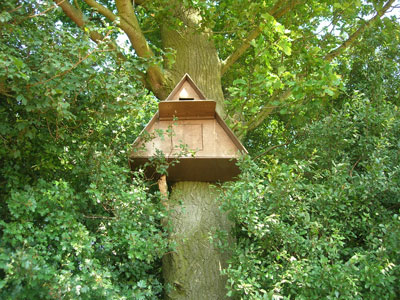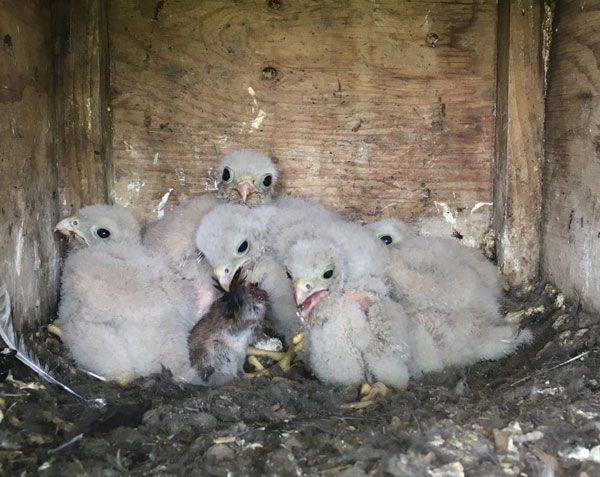Every year, the national Barn Owl Trust publishes a report on the “State of the UK Barn Owl Population”. This report aims to quantify Barn Owl populations throughout the country, as observed by numerous local volunteer groups.
Our East Anglia Nest Box Scheme is one such group. Established in 2002 and for the last 5 years run jointly as the S.O.S. & Thornham Owl Project Nest Box Scheme, it currently maintains and monitors around 300 wild owl nest boxes locally.
A Barn Owl nest box sited high in a tree, out of harms way
Within the context of the UK, the scheme works in tandem with the Suffolk Community Barn Owl Project. As a body, this is one of the larger local monitoring groups, checking 1,402 sites during 2017. The amalgamated Suffolk groups reported an encouraging increase, with 366 of the 1,402 sites being nested - 41 more nests than in the “bumper" year of 2014 and 51% more than the average of all previous years.
S.O.S. & Thornham Owl Project Nest Box Scheme Successes
Main man Roger, principal of our partners, the Thornham Owl Project, retrieves a pulli for weighing, measuring and ringing
2017 proved to be an exceptionally good one for the Thornham Owl and East Anglia Wild Owl Nest Box Project, recording 152 Barn Owl pulli (young birds ringed in the nest) in the year and surpassing our previous high of 2014.
In safe hands... working under a DEFRA-issued Disturbance Licence, the data collected by our project will be fed back to the Barn Owl Trust as a contribution to the annual survey. Approaching a wild owl nest box without such a licence is unlawful.
Nest box checking commenced in the first week in June and it was soon clearly evident by the amount of debris left in some boxes that in some cases pulli had already fledged. Our project leader Roger observed that in hindsight this was probably due to the very warm spell in late March, to which some Barn Owls possibly took advantage and commenced early breeding. Obversely, others started late breeding when the weather conditions took a turn for the worse in May, and as a result, our team were still ringing Barn Owl pulli in late September and well into October.
Not Only... But Also - Kestrel & Tawny Owl Results
This brood of seven young pullis evidence the encouraging results in the 2017 Kestrel camp
Another success story in 2017 found just under half of the 46 Kestrel nest boxes in our project being used, with a record 88 pulli being ringed - a pleasing 4.4 being the average brood size and surpassing the figure for 2012. This was an excellent result as the BTO (British Trust for Ornithology) now have the Kestrel as Amber Listed, being of conservation concern.
As Roger prepares to weigh the youngsters, a passer-by shows interest
Tawny Owl Concerns
2017 saw a reasonable year for Tawnies, with 10 boxes yielding 19 pulli. Though second only in results to our record year in 2014, there is an urgent need to expand our knowledge of this species.
A trio of Tawny owlets nestle amidst the detritus that accumulates inside a busy nest box, which the team will clean when the opportunity arises later in the in the year.
We need to be in the best possible position to provide advice on issues that may impact Tawny Owls, whether they are in planning policy, alterations to agri-environment schemes, the management of our woodland estates or climate change. The BTO is organising a survey to establish the demise of this specie, aiming to bring more people into contact the Tawny Owls to improve our knowledge of how their population is faring and working with local groups to support monitoring work.
We would like to take this opportunity to thank Thornham Owl Project volunteers Roger and Kevin who, supported by Suffolk Owl Sanctuary volunteer Steve and funded by the contributions made by S.O.S. supporters, tirelessly build and venture out to erect, monitor and repair or replace the wild owl nest boxes in our joint venture, for which Roger collates and then submits the detailed information that the Barn Owl Trust study depends upon.






